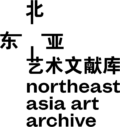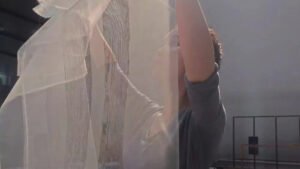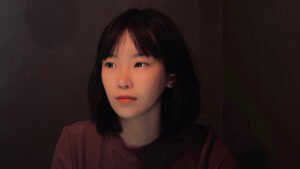
Dandong, a small border town located in the northeast, faces North Korea across the river. In the intertwining of history and geopolitics, it has become a specimen witnessing the changes in the relationships among Northeast Asian countries and the political dynamics of the region. However, the story of Dandong is far more complex than labels suggest. It is a field of multiple narratives, constantly evolving amid the uncertainties and dynamics of the border. The history of Dandong is not just the past but a living process, continuously being reinterpreted and questioned.
Located on the China-North Korea border and built on this complex historical and geographical backdrop, the Yalu River Art Museum has become a supporter of exploration and experimentation. According to its founder, Ji Dahai, the purpose of art is not to retell history but to express an attitude and a profound reflection on history, culture, and borders, coupled with an urgent exploration and anticipation of the unknown world. It serves as a bridge connecting the past and present, self and others. Thus, in this city of history, art moves like a life form slowly writhing in the mist, challenging the boundaries of discourse in its own unique way.
Establishing a contemporary art museum in a border area is no easy task. For Ji Dahai, nurturing a dream in a barren land means facing numerous practical challenges rather than pursuing vague illusions. Since the inception of the museum, he was well aware that he must abandon fantasies and confront reality, building the most basic operational mechanism rationally and firmly to ensure its long-term sustainability. He mentioned that the development path of each museum must be tailored to the surrounding resources and the key survival principle is to ensure suitability to its specific circumstances. In this process, the difficulties encountered also become new experiences and possibilities.
As the only art museum invited to the “New Voices of Northeast China” project, the “borderland” represents both a challenge and an opportunity for the Yalu River Art Museum. It is not confined within a narrow, local framework but rather uses the region as a starting point for its broad narrative. Within a clear framework and mindful decision-making, the Yalu River Art Museum, though “sparsely attended,” advances steadily. Its experimental value injects new vitality into this land.
1
As a local of Dandong, I am very familiar with the cultural and social environment here. I know very well that establishing a contemporary art museum here is like nurturing a dream in barren soil. For this reason, we have adopted an attitude of abandoning illusions and facing reality from the very beginning. Even though the surrounding environment was still thriving around the time we opened in 2015, we took a rational view of the museum’s future. We built the museum’s operational mechanism based on the most basic framework in order to ensure its long-term operation in Dandong. Insiders are quick to realize that running a private museum while relying on support from foundations and sponsors, or surviving through revenue from merchandise and ticket sales, is often a beautiful myth. External experiences are difficult to translate into reality. Each museum must find its own development path and formulate survival rules suited to its specific circumstances based on the surrounding resources.
We often say that an art museum is a spiritual sanctuary for people nowadays, and a private art museum is a means of embedding personal will into the local cultural development. This narrative is exciting and injects the act of establishing a museum with a sense of mission. When defining the museum’s academic position, we infuse it with ideals and sentiments, refusing to settle for conventional, follow-through projects. When I founded the Yalu River Art Museum, I received academic support from several close friends and harbored a utopian dream. We believed that the museum’s mission is not to cater to the masses as catering leads to mediocrity. Instead, an art museum should be a leader in concepts and awareness. How to lead? This requires the museum to start with self-criticism and reflection. We attempt to lead ourselves through reflection and seek growth by subverting ourselves. Therefore, we position ourselves as an “experimental museum,” aiming to conduct transcendental and exploratory projects.
Even in first-tier cities, this type of exhibition often lacks a broad audience base. Therefore, we do not consider public education and popularity as factors in our project planning. Instead, we focus on creating an academic platform for exchanges among artists. This positioning allows us to happily accept a “sparsely attended” situation, as it proves that we have indeed ventured far enough to stand at the forefront of people’s existing experiences. However, we also believe that by keeping the museum continuously open to the public, it will naturally influence the relevant audience. Even if people question the exhibition, these issues arise within the framework of art. We are not rejecting the general public; rather, we aim to be an independent museum that does not cater to trends.
2
If art museums are places that produce knowledge, it depends on how we understand knowledge production. It is important to be skeptical about existing knowledge. Doing projects in the usual way is merely replication and fails to generate new knowledge. Yalu River Museum of Art tries to renew itself through a critical process of self-denial and self-subversion. A non-conformist attitude may generate new knowledge. For example, the concept of our annual exhibition “non-annual presentation” forces artists to give up the studio mindset and to explore the possibilities of site-specific and time-responsive creation. By engaging in the project with a fresh approach, many problems and dilemmas that have never been experienced before will arise, and new experiences and possibilities will be created.
“Non-annual presentation” is the academic positioning of the Yalu River Art Museum’s annual exhibition. Participating artworks must possess reasons that justify their manifestation for a certain period other than annually. This, together with the museum’s one-year exhibition period, forms its annual concept. The conceptualization of artworks evolves continuously during the exhibition period, creating a growing exhibition. It is a collaborative process between artists’ time-based practices and the framework of the museum’s annual exhibition. We invite artists who are willing to challenge themselves and explore new artistic languages to engage in experimental explorations of artistic language, exhibition aesthetics, and site-specific thinking with the museum. Even accomplished artists must create works here that differ from their past experiences and cannot repeat themselves, posing a challenge for both artists and the museum. Artists with fixed mindsets find this unacceptable. Some say that creating a “non-annual presentation” here is like writing a thesis, and this concept had to be repeatedly communicated. In previous projects, misunderstandings between the two parties have resulted in some works failing to reflect the temporality of the annual concept. However, as experimental art, I believe the process is more important than the result, and mistakes in those exhibitions are integral parts of experimental art.
Another project of the museum, “Annual Literature Exhibition,” is also constructed with a temporal approach. Only this takes longer, and it is a sequence of exhibitions that “A Beginning with No End,” treating “Annual Literature Exhibition” itself as a growing document. It is the same sequence of exhibitions, constructed by different annual literature exhibitions that continue to be extended, which leads to a variety of questions that curators and artists need to experiment and explore. Both art museums and artists are eager to break away from the boundaries of established experience and make changes in some way. But the accompanying price is to face the loneliness of not being recognized by the current society.
3
After the pandemic, by 2024, the Yalu River Museum of Art had not been hit too hard. This is not out of foresight, but because we are well aware of the confusing signals that would be sent to the industry if exhibition projects experience erratic funding in response to changes in the economic situation. We hope to continue to advance at a relatively stable pace, neither expecting to spread out projects nor interrupt them due to the deterioration of the environment. The academic positioning of the Yalu River Museum of Art is all associated with temporality. The contemporary art museum system is a blank slate in the northeastern region. Contemporary art is also marginalized in the local art scene. However, we believe that these disadvantages can be transformed into opportunities.
Before the founding of the Yalu River Art Museum, there had never been significant contemporary art exchange activities in Dandong. However, we had a group of genuinely pure contemporary artists here. We have hosted group exhibitions featuring four local artists from Dandong: Sun Shiwei, Liu Keyan, Yan Feng, and Lv Wenjing. Despite the almost non-existent communication, lack of attention, and absence of sales, they embarked on a continuous exploration of their artistic language for ten and even twenty years. They experimented relentlessly with artistic language, resolutely abandoning commercialized expressions and returning to the essence of artistic experimentation. Some faced financial hardship, with unheated studios in winter. Their perseverance was moving. When asked if they regretted their choices, their response was, “Now back to art itself, I am at peace.” Such pure dedication to art is rarely seen in first-tier cities and culturally developed regions. They had few opportunities for exhibition, therefore we initiated the “Duplex Hall” project, where works by Northeastern artists who have participated in our activities are permanently displayed in the museum’s informal exhibition space. This allows art industry guests visiting the museum to learn about them. This year, we will expand such display area. There are many artists like them in the northeastern region who need exhibition platforms. We will do our utmost, through formal and informal means, to make the industry aware of the existence and status of these artists.
4
Although we didn’t define the Yalu River Art Museum as a local art museum, artists who do projects here are attracted by the unique geography of the place, which is inevitable as this is the only art museum in the world situated on the borderline. However, the geographical border is natural and objective, and it is not directly related to the academic development of the museum. We try to use the term “border” instead of “frontier.” Frontiers refer to the boundary between countries, but as an art museum, it is necessary to present the academic boundary within the art museum system. The value of an art museum should be reflected through exhibitions and programs to show its awareness of independent academic boundaries, exploring the boundaries of art language and exhibitionism, and finding a suitable path for our own development without crossing the boundaries of established experience.
The Luxun Academy of Fine Arts, a school with long-standing history, has produced numerous art professionals in Dandong, which provides a solid foundation. We aim to facilitate effective interaction by engaging in exchanges with artists from different regions, allowing for a multi-perspective examination of the challenges artists commonly face. It’s widely known that artists often want to know which artists have previously worked in the same venue, and may even consider the relationship between neighboring artists’ works within the same exhibition. At Yalu River Art Museum, however, everyone works within the framework of “non-annual presentation.” Despite sharing the same theme, each artist employs different methodologies, creating an underlying sense of competition. In past annual exhibitions, young artists from the northeastern region have diversified the practice of the temporal concept of annual exhibitions, and some accomplished artists from other regions candidly acknowledged the pressure they felt. The inspiration is mutual. In our exhibition plans, we deliberately reserve some slots for artists from the northeastern region to promote the development of regional contemporary art. So far, the proportion of exhibiting artists in the museum is as follows: artists from the three northeastern provinces account for 41%, artists from other regions 50%, and foreign artists 9%.
Artists from other regions bring a fresh perspective to local elements. For example, for residents of Dandong, the view of North Korea is part of daily scenery, but for outsiders, it’s a peculiar spectacle. However, for artists, such scenes may be seen as a living museum. Due to the prominent geographical features of Dandong, local, off-site, and foreign artists approach projects here with different narrative methods to express similar scenes. This has a direct impact on local artists. For instance, in the project “The Lines We Draw,” exhibited at Yalu River Art Museum by Singaporean artist Zhao Renhui, he focuses on the ecological crisis of bird migration in the Yalu River wetlands in a contemporary artistic manner. Previously, local artists expressed the visual impact of waves of bird flocks from an aesthetic and lyrical perspective. Inspired by Zhao Renhui’s work, they realized that art is not only about expressing the sensory experiences of natural biological phenomena but also involves deeper issues such as geopolitical relations, ecological crisis, and the relationship between humans and nature, as seen in the freedom of bird migration unrestricted by national borders. Artists from different regions inspire each other when creating locally. Our museum does not solely aim to explore local values but rather uses the local context as a starting point to extend into different artistic concepts and integrate them into broader narratives.
5
Dandong’s history is inseparable from the overall narrative of Northeast China. As a once colonized immigrant city, it played a significant role in the historical evolution of the region. Since its opening in 1906, Dandong has been one of the most open cities in China for foreign trade. Despite its small size, countries like Britain, the United States, and Japan all established Consulates here. The urban architecture of Dandong was built by the Japanese, while the education and healthcare systems were established by the Danish. As the warmest area with the richest freshwater resources in the Northeast region, it attracted a large number of immigrants, forming a highly inclusive regional culture. Rich resources and geographical sensitivity made Dandong a focus of international attention at any time. In just over a hundred years, it has witnessed the First Sino-Japanese War, the Russo-Japanese War, and the Korean War. As a foothill of Changbai Mountain and the starting point of China’s eastern coastline, Dandong has its own unique temperament and development context and has become a melting pot of multiple ethnic cultures such as Han, Manchu, and Korean.
In recent years, within the framework of the “Northeastern Cultural Renaissance,” we’ve seen both Zhao Benshan-style entertainment sketch comedies, as well as deep literary explorations by authors like Shuang Xuetao and Ban Yu. These two starkly different artistic phenomena stem from the same region, suggesting that a flat perception of “Northeastern accents” is overly simplistic. In the realm of contemporary art, influential figures such as Yin Jinan, Jia Aili, He Xiangyu, Zhao Liang, and Liang Chen have emerged in just one city, Dandong, all embodying the unique temperament of North-easterners. However, it’s no longer feasible to simply label their works as “Northeastern,” as one might with literature and performance. How come there is no “Northeastern phenomenon” in the field of contemporary art, as it has in literature and performance? That’s an interesting question.
6
In recent years, I have traveled between Hong Kong and Dandong. Hong Kong is the most important gathering spot for art in Asia, where there are numerous outstanding senior art practitioners and art organizations. By talking to them, you can get the latest concepts and a wide range of resources, and cooperate on art projects between Hong Kong and Northeast China, which may become a way for local artists to be seen by the outside world. Dandong is on the border of China and on the edge of the Northeast, but in the range of China, Japan and South Korea as the semi-transit, Dandong is in the center. We aim to use the Yalu River Art Museum as a platform to continuously host exhibitions, artist residencies, art forums, and other activities, to actively engage in regional cultural exchanges. The “Yalu River Forum”, scheduled to launch this September, serves as a platform focused on facilitating art exchange between Northeast China, the outside world, and the Northeast Asian region.
Artists from the Northeast have one thing in common, which is their pure artistic attitudes; they embody ruthlessness, endurance, and resilience. However, if they lack open vision, they could get stuck in a rut. There is a musician in Dandong whom I respect very much, Mr. Liu Guiteng, who has a profound study of shamanic music and carried out arduous and extensive field research many years ago, and I am often attracted by his magical experience of examining shamanic culture in the wilderness. His vision was not limited to Dandong and the Northeast region. He looked to the whole world and found that the use of the unilateral drum, which is an important ringing instrument of shamanic music, runs through the global alpine zone north of the 40th degree of north latitude, from the core area of North Asia, all the way to the Eskimos of Northern Europe and the Indians of North America. His academic achievement, Drum Language, which has become a worldwide model on the subject of religious music, is an example of a global influence from the Dandong region. This is also the reason why the Yalu River Art Museum does not position itself as a local art museum.


